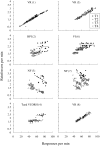On the primacy of molecular processes in determining response rates under variable-ratio and variable-interval schedules
- PMID: 18338672
- PMCID: PMC2211438
- DOI: 10.1901/jeab.2008.89-5
On the primacy of molecular processes in determining response rates under variable-ratio and variable-interval schedules
Abstract
This study focused on variables that may account for response-rate differences under variable-ratio (VR) and variable-interval (VI) schedules of reinforcement. Four rats were exposed to VR, VI, tandem VI differential-reinforcement-of-high-rate, regulated-probability-interval, and negative-feedback schedules of reinforcement that provided the same rate of reinforcement. Response rates were higher under the VR schedule than the VI schedule, and the rates on all other schedules approximated those under the VR schedule. The median reinforced interresponse time (IRT) under the VI schedule was longer than for the other schedules. Thus, differences in reinforced IRTs correlated with differences in response rate, an outcome suggestive of the molecular control of response rate. This conclusion was complemented by the additional finding that the differences in molar reinforcement-feedback functions had little discernible impact on responding.
Figures



Similar articles
-
Concurrent VR VI schedules: primacy of molar control of preference and molecular control of response rates.Learn Behav. 2010 Nov;38(4):382-93. doi: 10.3758/LB.38.4.382. Learn Behav. 2010. PMID: 21048229
-
The copyist model of response emission.Psychon Bull Rev. 2012 Oct;19(5):759-78. doi: 10.3758/s13423-012-0267-1. Psychon Bull Rev. 2012. PMID: 22673925 Review.
-
Response rate and sensitivity to the molar feedback function relating response and reinforcement rate on VI+ schedules of reinforcement.J Exp Psychol Anim Behav Process. 2007 Oct;33(4):428-39. doi: 10.1037/0097-7403.33.4.428. J Exp Psychol Anim Behav Process. 2007. PMID: 17924790
-
Free-operant performance on variable interval schedules with a linear feedback loop: no evidence for molar sensitivities in rats.J Exp Psychol Anim Behav Process. 2000 Oct;26(4):416-27. doi: 10.1037//0097-7403.26.4.416. J Exp Psychol Anim Behav Process. 2000. PMID: 11056882
-
The linear system theory's account of behavior maintained by variable-ratio schedules.J Exp Anal Behav. 1988 Jan;49(1):143-69. doi: 10.1901/jeab.1988.49-143. J Exp Anal Behav. 1988. PMID: 3279150 Free PMC article. Review.
Cited by
-
Concurrent VR VI schedules: primacy of molar control of preference and molecular control of response rates.Learn Behav. 2010 Nov;38(4):382-93. doi: 10.3758/LB.38.4.382. Learn Behav. 2010. PMID: 21048229
-
Inter-response-time reinforcement and relative reinforcer frequency control choice.Learn Behav. 2015 Mar;43(1):54-71. doi: 10.3758/s13420-014-0161-y. Learn Behav. 2015. PMID: 25515591
-
Toward the Unification of Molecular and Molar Analyses.Behav Anal. 2013 Fall;36(2):295-312. doi: 10.1007/BF03392316. Behav Anal. 2013. PMID: 28018041 Free PMC article.
-
Discrimination of variable schedules is controlled by interresponse times proximal to reinforcement.J Exp Anal Behav. 2012 Nov;98(3):341-54. doi: 10.1901/jeab.2012.98-341. J Exp Anal Behav. 2012. PMID: 23144509 Free PMC article.
-
The copyist model of response emission.Psychon Bull Rev. 2012 Oct;19(5):759-78. doi: 10.3758/s13423-012-0267-1. Psychon Bull Rev. 2012. PMID: 22673925 Review.
References
MeSH terms
LinkOut - more resources
Full Text Sources

